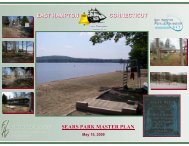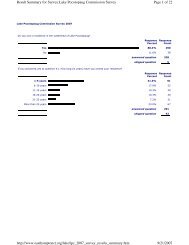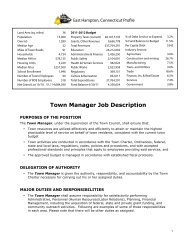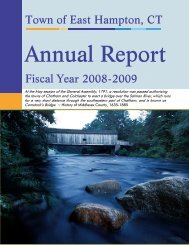Environmental Site Overview - East Hampton, Connecticut
Environmental Site Overview - East Hampton, Connecticut
Environmental Site Overview - East Hampton, Connecticut
You also want an ePaper? Increase the reach of your titles
YUMPU automatically turns print PDFs into web optimized ePapers that Google loves.
SECTION 4 INITIAL ENVIRONMENTAL CONCERNS<br />
Tighe&Bond<br />
buildings removed. Currently, the property looks much the same as it did in 1986.<br />
Only the water tower and the two recent buildings remain.<br />
Gong Bell Company<br />
Current reference location: <strong>Site</strong> number 11 on Figure 2 incorporates the former location<br />
of the Gong Bell Company.<br />
The Gong Bell Company was located directly across Walnut Avenue from the <strong>East</strong><br />
<strong>Hampton</strong> Bell Company. The 1903 Sanborn Map references the building as the<br />
National Novelty Corporation – The Gong Bell Manufacturing Company Branch. The<br />
National Novelty Corporation was based in New Jersey and was in existence from<br />
1903-1907. The corporation was a trust or consortium of over 30 leading<br />
manufacturers of cast-iron and wood toys, formed to cut costs and stifle competition.<br />
Poorly managed, the "Toy Trust" soon failed (The <strong>Connecticut</strong> Magazine). The 1914<br />
and 1925 Sanborn Maps refer to the property as The Gong Bell Manufacturing<br />
Company. Presumably the name change occurred during the dissolution of the National<br />
Novelty Corporation.<br />
Review of the 1903 Sanborn Map shows three main buildings associated with the<br />
industrial operations. From east to west, the first building was one-story and was used<br />
for storage. The next building was also one-story and used to store lumber. The third<br />
building was 2 ½ stories. The first floor was used for storage, box making, and<br />
painting. The second floor was used for assembling and packing. The attic was used<br />
for additional storage. The Sanborn Map also depicts a large pond (Fourth Pond)<br />
surrounding the property. The power for the industry is listed as water, the heat was<br />
derived from coal and wood stoves, and electricity was used for the lighting.<br />
The 1925 Sanborn Map depicts the consolidation of the three buildings into one long<br />
building with frontage to Walnut Street. An equally long addition was constructed onto<br />
the western side of the building. This new edition was designated as a stock room.<br />
The Sanborn Maps also shows the Fourth Pond as greatly reduced in volume. It is<br />
likely that the pond was reduced, in part, to accommodate the building addition.<br />
The 1970 aerial photograph portrays a large industrial growth around the area. An<br />
industrial complex was built slightly south of the former Gong Bell Company. Based<br />
on current property boundaries, these recent industrial buildings were part of 101 and<br />
103 Main Street. During this period, the BSR Corporation Sheet Metal Company<br />
occupied this address. By 2001, the northern buildings associated with 103 Main Street<br />
were removed. Also, the former Gong Bell Manufacturing Company has been<br />
incorporated into the Carpenter-Hayes Paper Box Company.<br />
M.L. Carpenter<br />
Current reference location: The Carpenter-Hayes Paper Box is still in operation and<br />
located on 8 Walnut Avenue, site number 11 on Figure 2.<br />
<strong>Environmental</strong> <strong>Site</strong> <strong>Overview</strong> 4-9







